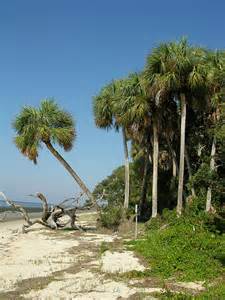
by Rick O'Connor | Aug 7, 2015
First let me explain that Seahorse Key is not in the Florida Panhandle but the story is interesting and a similar phenomena could occur here. Seahorse Key is an isolated island 3.6 miles southwest of Cedar Key in Florida’s Big Bend. There is a science lab owned and maintained by the University of Florida and Captain Kenny McCain on the island but can only reached by boat. Many forms of wildlife, particularly birds, seek out these isolate islands for nesting due to the lack of predators; and Seahorse Key is no exception. Another interesting point about this island is that it may have the highest density of cottonmouths in the state. Dr. Coleman Sheehy has been studying this population and estimates that there may be about 600 cottonmouths on the island. So what is the mystery?
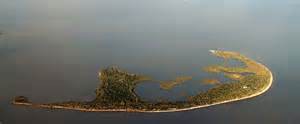
Seahorse Key. An isolated island near Cedar Key
Photo: FMSEA
Well we will first look back to last year and the nesting habits of the island’s birds. In 2014 Vic Doig of the U.S. Fish and Wildlife Service had logged seven different species of egrets, herons, cormorants, pelicans, and ibis nesting on the island. The number of nest per species varied from 100 to 5,000 with the white ibis producing the highest number. Dr. Sheehy surveys the cottonmouths by walking the shoreline and counting the number of snakes he encounters; which is typically around 30. The snakes and nesting birds are concentrated near Gardiners Point. Though the cottonmouths feed on rats they seem to rely on the fish that fall from the nests above.
As 2015 began the biologists noticed something different right off the bat. Though the birds were returning they were not returning in typical numbers, particularly the white ibis. These birds normally are the most abundant nesters on the island, but not this year. Dr. Peter Frederick, University of Florida’s Department of Wildlife Ecology and Conservation, did not seemed to alarmed by this knowing that white ibis are nomadic and do not stick with the same nesting locations for more than a few years. They tend to go where the food is most abundant. No mystery here… Then it happened…
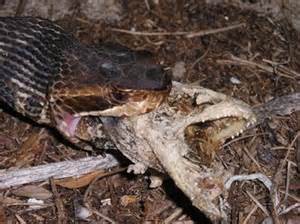
A cottonmouth consuming a fish from a birds nest.
Photo: University of Florida
Within a very short period of time, during the second week of April, all of the other birds began to leave. Researchers found the nests falling apart, no eggs or chicks within them, and hundreds of eggs on the ground. They also found the remains of 26 dead birds in the area. Where had they gone? What had happen?
Autopsied birds found no consistent cause of death. Most of the eggs on the ground had small holes indicating they were preyed upon by birds, most probably fish crows. However these birds are more opportunistic scavengers and would have fed on the eggs only after they had fallen from the nests. Researchers then discovered that many of the birds had relocated to nearby Snake Key. Though they had begun nesting there, fewer than half had done so. All seven species were found there but the number of nests had dropped from 100 – 5,000 to 50 – 600. Many of the birds were still missing. Where did they go? Better yet, why was Snake Key selected and Seahorse abandoned? And did the exodus of birds from Seahorse impact the snakes? The answer is… Yes. Dr. Sheehy’s survey found that the number of snakes encountered along the forest edge had dropped from 30 to 10. He noticed these snakes were thinner and he observed one cottonmouth consuming another, something he had not noticed before. The snakes had been impacted by the decline in nesting birds. What had happened on Seahorse Key?
One idea was put forth by Dr. Sheehy. He had noticed an increase in the number of raccoons on the island. Again, these isolated islands are selected for by nesting birds because of the lack of such predators and Dr. Harvey Lillywhite indicated that the typical number of raccoons on the island is zero. But Dr. Sheehy and Captain McCain had trapped and relocated seven raccoons earlier this summer. This suggests that a large group (large for this island) had found their way to Seahorse Key. Dr. Sheehy suggests that the cause of the movement of birds were the raccoons. There is no evidence of them attacking the birds but they believe the shear presence of the animals was enough for the birds to relocate. However Dr. Fredrick points out that (a) there was little evidence of the raccoons preying on the fallen eggs and (b) he could not find track or scat evidence of more than one or two raccoons on the island during his initial survey after the birds left. He is not so sure the raccoons were the cause.
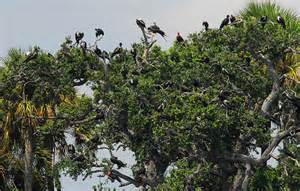
Nesting birds on Seahorse Key
Photo: courtesy of flickr
Then there is the question… Where did the seven raccoons trapped come from? One suggestion was that they were released by locals. This was based on the fact that raccoons captured were well fed and had a mild temperament, not what you typically encounter with trapped raccoons from the wild. Later there was a confirmed report of a local who does take in orphaned raccoons, raises them, and releases them; they could have released some on Seahorse Key – but this has not been confirmed.
So right now this mystery remains unsolved. But the story does indicate the types of problems that can occur when humans relocate animals to habitats they do not typically live in. It takes years for Mother Nature to develop a balance only to have it quickly fall apart by the human release of animals we wish to move or that we think will do better in another location.
You can read more on this story at:
http://fieldguide.blogs.gainesville.com/427/amysteryatseahorsekey/
http://fieldguide.blogs.gainesville.com/450/a-mystery-at-seahorse-key-part-2/
by Judy Biss | Jul 18, 2015
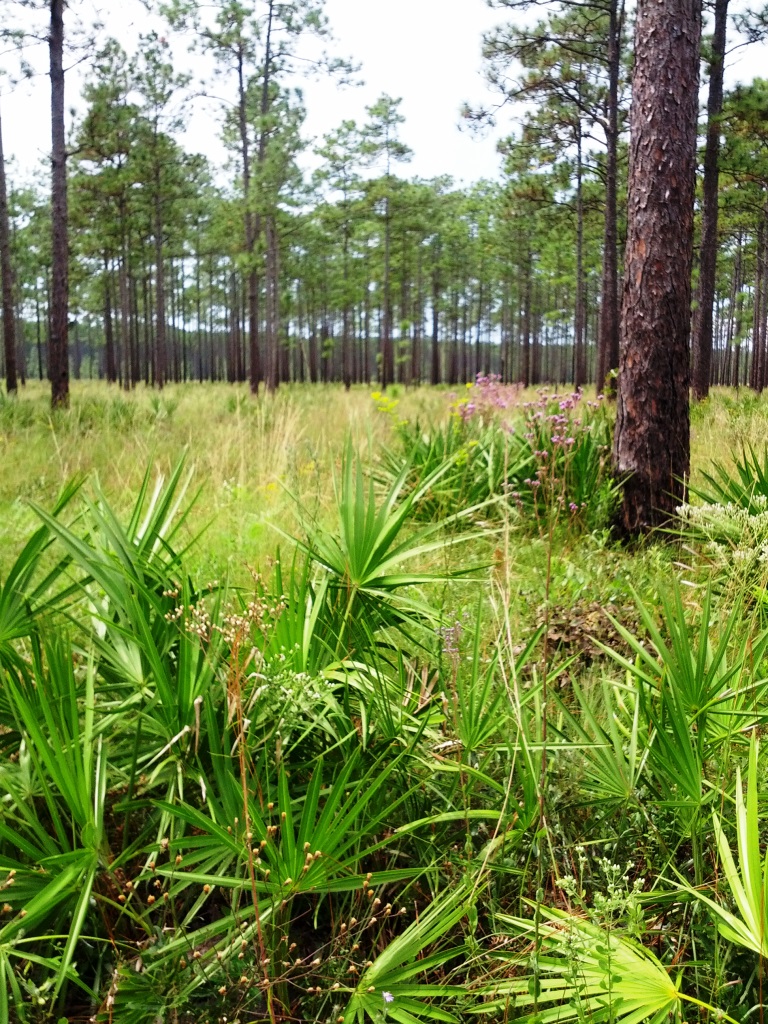
Woodlands and rangelands are important to both our economy and environment. Photo by Judy Ludlow
Most of us living in panhandle Florida recognize that our farmers and ranchers are committed to sustainable production of food, fiber, and fuel for generations to come, but how will farmers continue to be productive while sharing natural resources with an ever growing population and an intricate environment? How will Florida’s agricultural lands, rangelands, and woodlands continue to contribute to the quality of our environment and to our economy?
Florida Rangelands:
According to the USDA Natural Resources Conservation Service “Range and pasture lands are diverse types of land where the primary vegetation produced is herbaceous plants and shrubs. These lands provide forage for beef cattle….and other types of domestic livestock. Also many species of wildlife…depend on these lands for food and cover.” Florida’s rangelands and woodlands are a significant component of Florida’s agricultural industry.
According to the 2012 Census of Agriculture there were:
- 3,749,647 acres of permanent pasture and rangeland in Florida
- 1,368,171 acres of pastured woodland in Florida
Benefits of Rangelands:
Florida’s 5.1 million acres of agricultural rangelands and woodlands not only support the economy, but abundant wildlife too. These well managed lands are living systems sustaining livestock, wildlife, and healthy soils. Benefits of these lands include important economic and ecological services like reducing our carbon footprint, increasing water conservation, providing forage for livestock, habitat for wildlife and game, preservation of cultural heritage, and sustainable timber. Additionally, hunting, fishing, and wildlife viewing is a multi-billion dollar industry within which Florida’s rangelands play a significant role. Florida’s rangelands are also important for the continued survival of many threatened species like the Crested Caracara, Snail Kite, Gopher Tortoise, Florida Scrub-Jay, Eastern Indigo Snake, Roseate Spoonbill, Wood Stork, and Sandhill Cranes.
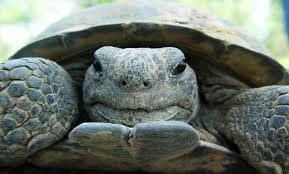
Gopher Tortoise. Photo by Chuck Bargeron, University of Georgia, Bugwood.org
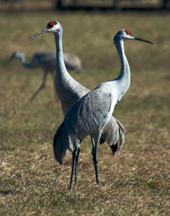
Sandhill Cranes in a North Florida pasture. UF/IFAS Photo by Josh Wickham.
Challenges to Florida’s Rangelands:
Threats to Florida rangelands include conversion into urban areas and fragmentation of large tracts of lands causing disconnection from other farmlands and natural areas. Contiguous, connected “wildlife corridors,” are important for many species of wildlife. Additionally, the establishment of non-native, invasive animals and plants; and alterations of natural and necessary processes such as fire, floods, and droughts, can disrupt the full economic and environmental potential of these lands.
Agricultural Best Management Practices and Education:
Today’s farmers use best management practices (BMPs) relying on up-to-date technologies and research to protect Florida’s unique natural resources, especially our precious water, while at the same time maximizing their production. BMPs are based on University of Florida Institute of Food and Agricultural Sciences (UF/IFAS) research and are practical, cost-effective actions that agricultural producers can take to conserve water and reduce the amount of pesticides, fertilizers, animal waste, and other pollutants entering our water supply. They are designed to benefit water quality and water conservation while maintaining or even enhancing agricultural production. According to the Florida Department of Agriculture and Consumer Services, for example, agricultural producers save 11 billion gallons of water each year by their conservation practices.
Many of Florida’s rangeland and woodland owners also take advantage of educational programs available to them such as the UF/IFAS Forest Stewardship Program. The mission of this multi-agency program is to help and encourage private landowners to manage their lands for long-term environmental, economic, and social benefits. According to their annual report: “In 2014 the Program reached 503 landowners and professionals directly with workshops and field tours. These landowners and professionals collectively own and/or manage over 2 million acres across Florida.”
Summary and Additional Resources:
Florida’s agriculture producers are deeply committed to being stewards of their lands and our surrounding environment. Their adoption and support of best management practices as well as continuing education is critical for sustainable production and also for feeding the world of the future.
For more information on this topic please see the following resources:
UF/IFAS Forest Stewardship Program
UF/IFAS Extension – Range Cattle Research and Education Center
UF/IFAS Extension – Best Management Practices
Florida Farm Bureau’s County Alliance for Responsible Environmental Stewardship Program (This Farm CARES)
Florida Department of Agriculture and Consumer Services – Best Management Practices
The Nature Conservancy – Florida Ranchlands
Food and Agriculture Organization of the United Nations – Grasslands and Rangelands
USDA Natural Resources Conservation Service
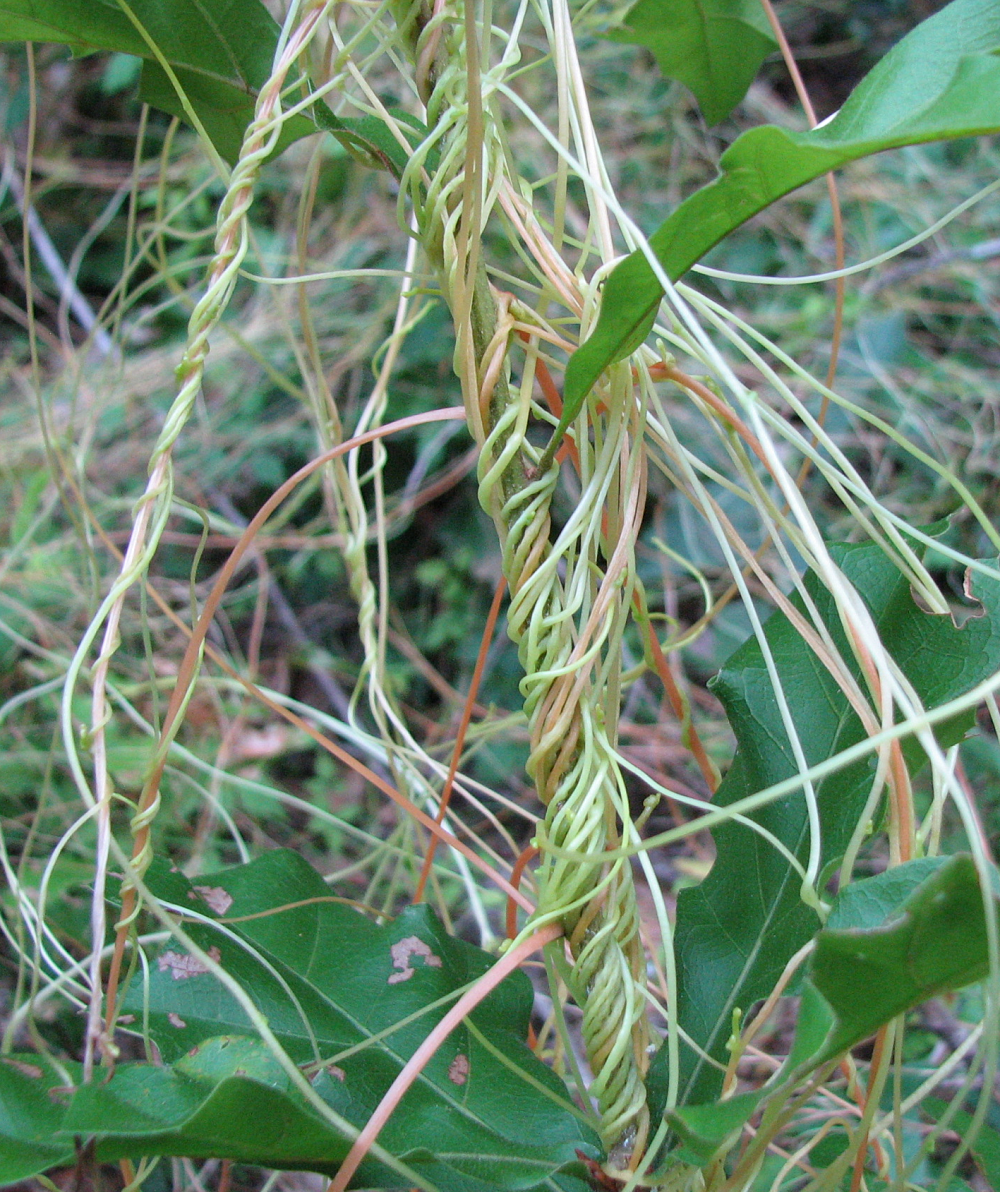
by | Jul 10, 2015
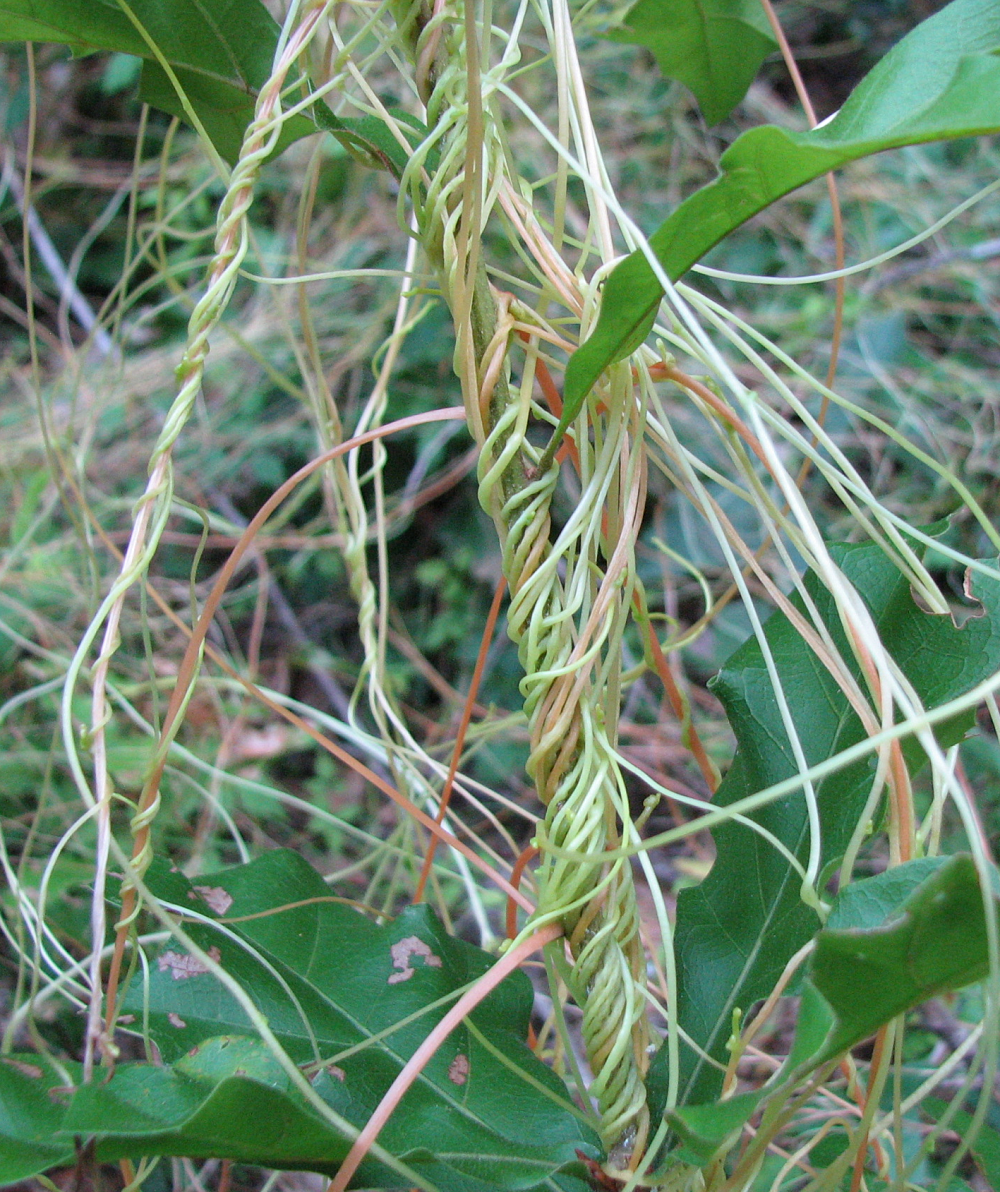
Dodder vines covering an oak seedling. The vines always wrap counterclockwise.
Photo Credit: Jed Dillard
Vampires of all types and genetic modifications are hot topics these days, and a common, but uncommon looking and acting Florida weed may have combined the two subjects. Dodder, a native invasive, parasitic plant, reproduces by seed but does not have enough leaves or chlorophyll to feed itself. Its thin, golden vines and tendrils must attach to a host plant in the seven to ten days it takes the plant to exhaust the carbohydrates in its small seed. Once dodder attaches to a plant, it connects to the inside of the host using small structures called haustoria which press into the stem and begin to draw nutrients from the host. At this point the dodder roots atrophy.
Single dodder plants are not a big issue, but once enough plants build up in an area large mats of vines can reduce growth and vitality of the host. (See photo) Frequently, the pest has reached this stage before it’s noticed, leaving the problem of treating a rootless, nearly leafless plant that is wrapped around a more desirable plant. Not only are the typical routes of herbicidal entry minimized, the hosts are at as much risk as the pest. Hand removal may be practical in small outbreaks, but the plant can reemerge from any small piece left attached to the host. In most cases, the solution is to destroy the host and the dodder and apply a pre-emergent herbicide to stop germination from any seeds remaining in the soil.
What about the GMO angle?
Work published last year in the journal Science by Jim Westwood of Virginia Tech reveals the dodder plant exchanges messenger RNA with tomato and Arabidopsis plants when it extracts the juices from the host plant. Scientists speculate this exchange of genetic material makes the host plant less resistant to attack by the parasite and that this holds promise for learning more about controlling other parasitic plants.
If plants are exchanging messenger RNA, a critical part of protein and gene synthesis, what other genetic exchanges are occurring naturally without our knowledge? Scientific progress hinges on unpredictable events and sources. Learning more from a “vampire weed” that has no easy means of control may be one of those.
To see the dodder plant go from seed to golden mat, watch this time lapse video Virginia Tech has posted on Vimeo. http://www.vtnews.vt.edu/articles/2014/08/081514-cals-talkingplants.html
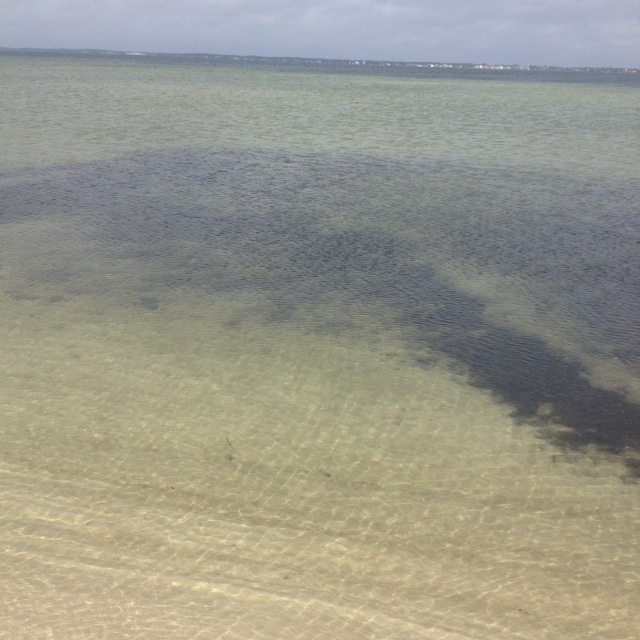
by Rick O'Connor | May 15, 2015
Following a previous article on the number of ways you can help sea turtles, this week we will look at ways that local residents can help keep our waterways clean. Poor water quality is a concern all over the country, and so it is locally as well. When we have heavy rain all sorts of products wash off into streams, rivers, bays, and bayous. The amount and impact of these products vary but most environmental scientists will agree that one of biggest problems is excessive nutrients.
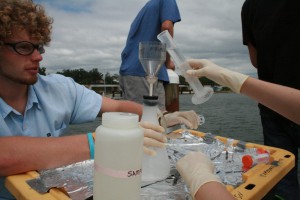
Marine science students monitoring nutrient levels in a local waterway. Photo: Ed Bauer
Nutrient runoff comes in many forms. Most think of fertilizers we use on our lawns but it also includes grass clippings, leaf litter, and animal waste. These organic products contain nitrogen and phosphorus which, in excess, can trigger algal blooms in the bay. These algal blooms could contain toxic forms of microscopic plants that cause red tide but more often they are nontoxic and cause the water to become turbid (murky) which can reduce sunlight reaching the bottom, stressing seagrasses. When these algal blooms eventually die they are consumed by bacteria which require oxygen to complete the process. This can cause the dissolved oxygen concentrations to drop low enough to trigger fish kills. This process is called eutrophication. In addition to this, animal waste from birds and mammals contain fecal coliform bacteria. These bacteria are used as indicators of animal waste levels and can be high enough to require health advisories to be issued.
So what we can do about this?
- We can start with landscaping with native plants to your area. Our barrier islands are xeric environments (desert-like). Most of our native plants can tolerate low levels of rain and high levels of salt spray. If used in your yard they will require less watering and fertilizing, which saves the homeowner money. It also reduces the amount of fertilizer that can reach the bay.
- If you choose to use nonnative plants you should have your soil tested to determine which fertilizer, and how much, should be applied. You can have your soil tested at your county Extension Office for a small fee. Knowing your soil composition will ensure that the correct fertilizer, and the correct amount, will be used. Again, this reduces the amount reaching the bay and saving the home owner money.
- Where ever water is discharged into the bay you can plant what is called a Living Shoreline. A Living Shoreline is a buffer of native marsh grasses that can consume the nutrients before they reach the bay and also reducing the amount of sediment that washes off as well, reducing the turbidity problem many of our seagrasses are facing.
These three practices will help reduce nutrient runoff. In addition to lowering the nutrient level in the bays it will also reduce the amount of freshwater that enters. Decrease salinity and increase turbidity may be the cause of the decline of several species once common here; such as scallops and horseshoe crabs. Florida Sea Grant is currently working with local volunteers to monitor terrapins, horseshoe crabs, and scallops in Escambia and Santa Rosa counties. We are also posting weekly water quality data on our website every weekend. You can find each week’s numbers at http://escambia.ifas.ufl.edu. If you have any questions about soil testing, landscaping, living shorelines, or wildlife monitoring contact Rick O’Connor at roc1@ufl.edu. Help us improve water quality in our local waters.
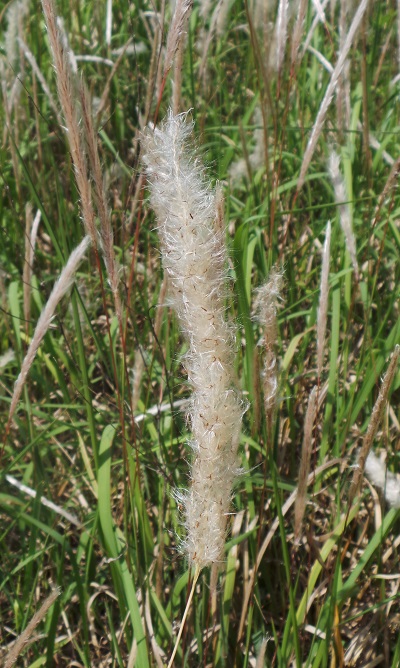
by Mark Mauldin | May 10, 2015
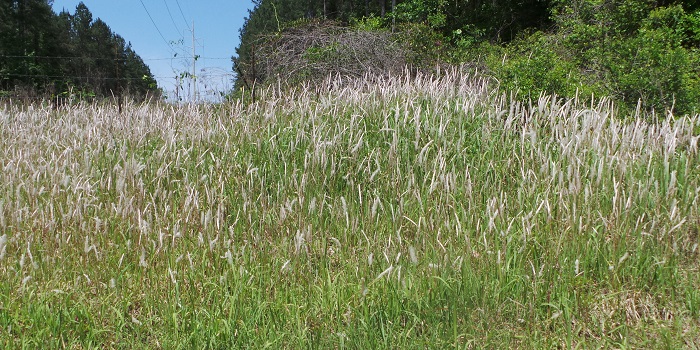
Cogongrass seedheads are easily spotted this time of year.
Photo Credit: Mark Mauldin
We are well into spring and a wide variety of plants are showing off their colorful blooms. As lovely as most of the blooms are, some springtime colors are an unwelcome sight. Such is the case with the showy, white seedhead that is produced by Cogongrass (Imperata cylindrica). The presence of Cogongrass – a highly aggressive, invasive, perennial – in Florida is not news; it has been in Florida since at least the 1930’s. However, the white seedhead that it produces in the spring makes it easier to locate and identify. When the seedhead is not present, the somewhat boring looking grass has the ability to blend in with its surroundings. This makes it harder for un-expecting landowners to identify the new/small infestations which are much easier to eliminate than are larger, well established infestations.

While cogongrass spreads primarily by rhizomes the seedheads can make new infestations easier to find.
Photo Credit: Mark Mauldin
Controlling cogongrass is not easy but it is necessary. If left uncontrolled cogongrass will continue to aggressively spread, displacing other desirable vegetation. Generally speaking, control is a multi-year process. Because the specific recommendations for controlling cogongrass can vary somewhat by situation it is highly advisable that you contact a UF/IFAS Extension Agent in your county if you suspect that you have cogongrass on your property.
The following description of cogongrass from UF/IFAS Center for Aquatic and Invasive Plants should help you identify cogongrass, even if the seedheads are gone.
“Cogongrass is a perennial that varies greatly in appearance. The leaves appear light green, with older leaves becoming orange-brown in color. In areas with killing frosts, the leaves will turn light brown during winter months and present a substantial fire hazard. Cogongrass grows in loose to compact bunches, each ‘bunch’ containing several leaves arising from a central area along a rhizome. The leaves originate directly from ground level and range from one to four feet in length. Each leaf is 1/2 to 3/4 of an inch wide with a prominent, off-center, white mid-rib. The leaf margins are finely serrated; contributing to the undesirable forage qualities of this grass. Seed production predominately occurs in the spring, with long, fluffy-white seedheads. Mowing, burning or fertilization can also induce sporadic seedhead formation. Seeds are extremely small and attached to a plume of long hairs.”
This is the time of year when cogongrass is the easiest to identify. Take advantage of this opportunity to locate new infestations and work with your county agent to develop a control plan. Once a plan is in place, follow it to the end. Stopping after the first year will practically ensure that control will not be achieved.
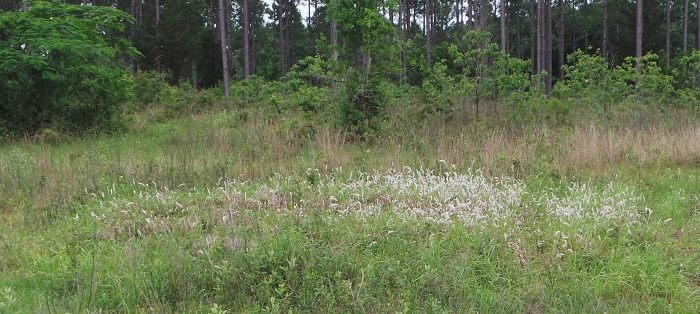
A relatively new patch of cogongrass recently found in Washington County.
Photo Credit: Mark Mauldin
More information on cogongrass can be found by following the links below
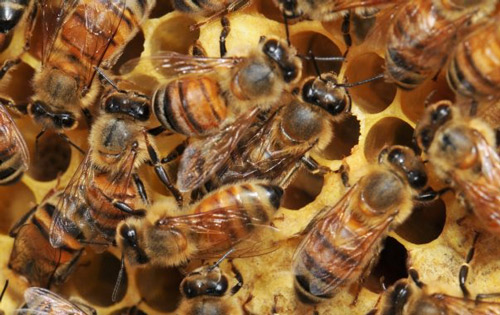
by Sheila Dunning | May 1, 2015
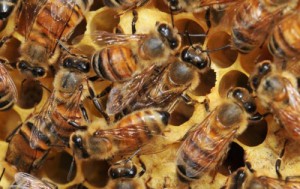
European Honey Bees
Photo: Ashley N. Mortensen; University of Florida
Bees have been disappearing at an alarming rate and continue to vanish without a trace. Why should anyone care? Well, they matter a lot more than most people think. Bees are the overwhelmingly dominant pollinator for most food crops. Native bees in the United States are responsible for pollinating over $15 billion worth of agricultural commodities annually. However, native bee populations are in decline due to habitat loss. At the same time, managed colonies of European honey bees have suffered a 50% decline over the past few decades. Numerous other pollinating insects are facing the same fate.
As the spring planting season is upon us, it’s exciting to think about all the wonderful produce we will have this summer. But, without pollinators many of these crops would not be available. The majority of fruit and vegetable food sources we eat are dependent on insect pollinators. One of every three bites of food Americans consume comes from a plant visited by bees or other pollinators.
As declining numbers of farmers work to meet the needs of an increasing population, they are forced to make choices on alternative to chemicals for pest control. “Good bug blends” of flowers can help attract pollinators as well as beneficial insects that suppress harmful pests. Establishment of these meadows can be done on a small or large scale and in any habitat. One approach to “bringing back the pollinators” is to intercrop with blooming plants that attract insects. Selecting a diversity of plants with different flower sizes, shapes and colors, as well as various plant heights and growth habits, will encourage the greatest numbers of pollinators. It is important to provide a continuous source of pollen and nectar throughout the growing season. At minimum, strive for three species to be blooming at any one time; the greater the diversity the better.
To enhance the garden, choose flowering plants that also provide shelter for beneficial insects. Many companion plants are suitable habitat for predators and parasitoids. Research in Florida has demonstrated that predatory minute pirate bugs can build to high numbers in sunflowers. The favorite food of minute pirate bugs is Western flower thrips. So, planting sunflowers on the perimeter of vegetable crops, such as peppers, can greatly reduce the damage caused by the thrips. Similar results were found with the planting of sorghum to attract beneficial mites and intercropping with buckwheat to house syrphid flies and parasitoid wasps. The garden vegetables experienced fewer spider mite, whitefly and aphid problems. Crimson clover, Hairy vetch and cosmos are other annual seed crops that can aid in attracting pollinators and harboring beneficial insects.
Insectary meadows can be created in the landscape and along roadways, not just in the garden. For more permanently planted areas, native wildflowers, grasses and woody plants serve as larval host plants for butterflies, and also provide nesting and overwintering sites for bumble bees, predacious beetles and other beneficial insects. Native perennial wildflowers such as blanketflower, tickseed, black-eyed Susan, partridge pea, narrowleaf sunflower, milkweed, beebalm, goldenrod and silkgrass can be installed in the spring as potted plants or seeded in the fall. Seeds require exposure to cold temperatures and damp conditions before germination can occur. In Florida, the best time is November to February.
Though grasses do not offer nectar or high-quality pollen, it is often useful to include at least one native bunch grass or sedge. Short, clump-forming grasses are preferable to large, spreading grasses. Hedgerow planting of woody species is a way to provide winter-blooming plants vital for supporting pollinators. Woody plants and grasses provide more than forage for pollinators, as many native bee species nest in the stems of plants or in the undisturbed ground underneath plantings. Suitable grasses include: beaked panicgrass, purple lovegrass, Muhly grass, broomsedge,little bluestem, wiregrass and toothache grass. Favored woody species that make good “beetle banks” include: fetterbush, American beautyberry, saw palmetto, Chickasaw plum, red maple, sparkleberry, Dahoon holly, redbud, blackgum, magnolia, buttonwood and sourwood.
Regardless of whether the objective is to establish herbaceous or woody vegetation, the time and effort spent on eradicating undesirable plants prior to planting will result in higher success rates in establishing the targeted plant community. Choose level, open sites that receive full sunlight and have limited weed populations. If perennial weeds are a problem, the use of herbicides that have no soil residual (e.g. glyphosate) may be necessary.
For more information on establishing planting for pollinators visit: www.xerces.org/pollinator.
















